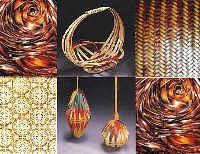| Home > Living in China > Art |
A Basic Knowledge about China Pottery
 |
|
Pottery warriors |
As time passed by, the technique became more and more perfect. Yangshao Culture, 5,000 - 7,000 years ago to today, developed a technique for painted pottery. Qujialing Culture and Longshan Culture, dating back about 4,000 years ago, were known for their black pottery. During the Shang Dynasty (16th - 11th century BC), bronze vessels grew into somewhat of a status symbol.
From the Warring States Period through the Han Dynasty, the art and culture of pottery thrived. In addition to creating everyday utensils, pottery warriors were created and buried with the grandees. During the Three Kingdoms Period (220 - 280), the forging technique of porcelain gradually replaced traditional pottery handiwork.
Another fine example of beautifully crafted pottery is the tricolor glazed pottery of the Tang Dynasty (618 - 907). The pieces were created by adding various metals oxide and baking at a low temperature. The glazed pottery would appear to be light yellow, reddish brown, shamrock or light green. The sculpting of figures, animals or daily appliances was amazingly in accord with the characteristics of Tang art - graceful and lively. Preferred by many foreigners to the region, the tricolor glazed pottery had been transported all over the world.
Another kind of pottery that won great reputation for hundreds of years is purple clay pottery. It is well-known for its mild color, condensed structure, high intensity and fine particles. As early as the Song Dynasty (960 - 1279), people found purple clay teapots to look much more graceful than those of other materials. In the Ming and Qing Dynasties, people who liked drinking tea firmly believed that tea in the purple clay pot smelled balmier and could retain the original quality; these teapots transferred heat slower and were more endurable of heat; after long time's use, the teapot would not fade but become more lustrous. Modern people still delight in this classic fashion ideal.
Art
 more
moreA Basic Knowledge about China
Pottery warriors Pottery may be the oldest

China’s Four Treasures of Study

China Crafts Diverse in Styles
Chinese bamboo craftsAs a gem of Chinese art and

Customs
 more
more



 print
print  email
email  Favorite
Favorite  Transtlate
Transtlate 
